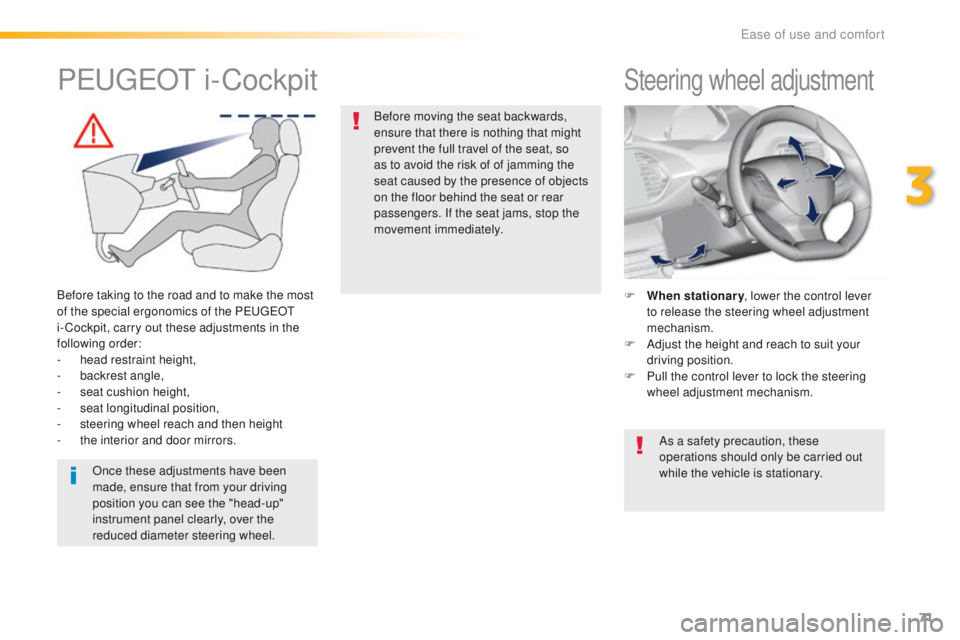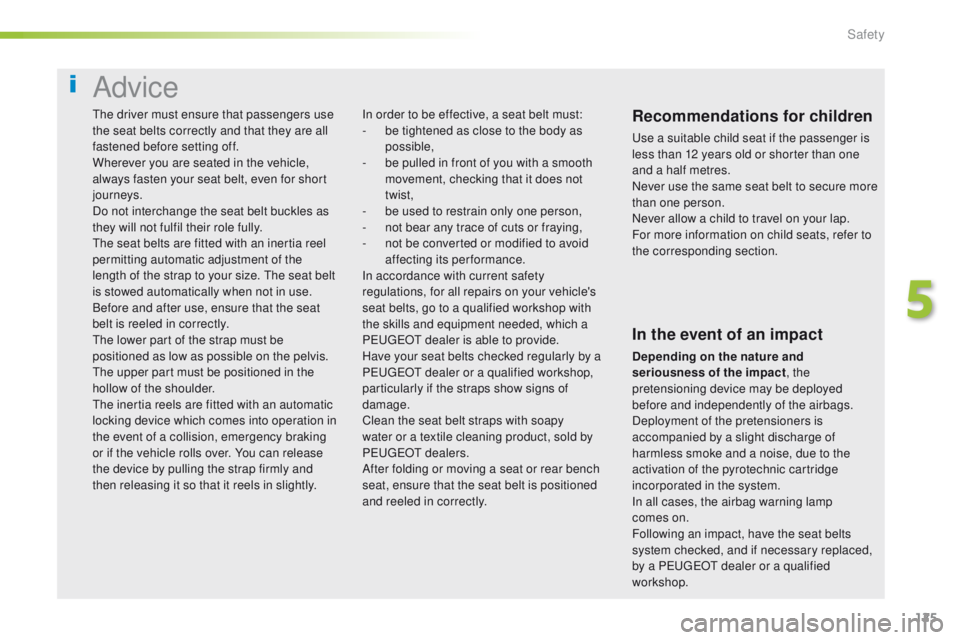Page 4 of 396

.
.
Over view
Instrument panel 12
Indicator and warning lamps
1
3
ga
uges and indicators
2
8
Distance recorders
3
2
tr
ip computer
3
4
to
uch screen
3
7
Setting the date and time
4
4Remote control key
4
8
"Keyless e
n
try and Starting" with remote
control 54
"Keyless e
n
try and Starting"
on your person
5
6
Boot
59
Alarm
65
el
ectric windows
6
9
P
e
uge
Ot
i- Cockpit
7
1
Steering wheel adjustment
7
1
Front seats
7
2
Rear seats (hatchback)
7
7
Rear seats (SW)
7
8
Interior fittings
8
0
Front armrest 8 2
Boot fittings (hatchback)
8
6
Boot fittings (SW)
87
H
eating and Ventilation
9
0
Heating
9
2
Manual air conditioning
9
2
Manual air conditioning (
to
uch screen)
9
4
Dual-zone digital air conditioning (
to
uch screen)
9
6
Front demist - defrost
1
01
Rear screen demist - defrost
1
02
Panoramic sunroof
1
03
Courtesy lamps
1
04
Interior mood lighting
1
05Mirrors
10 6
Lighting control stalk
1
08
Direction indicators
1
11
Daytime running lamps
1
12
Automatic illumination of headlamps
1
12
Side spotlamps
1
14
Headlamp beam height adjustment
1
14
Wiper control stalk
1
15
Automatic rain sensitive wipers
1
17
Hazard warning lamps 1 19
em
ergency or assistance call
1
19
H or n
12
0
e
SC system
1
20
Seat belts
1
23
Airbags
1
26
Child seats
1
30
Deactivating the passenger's front airbag
1
33
ISOFIX mountings and child seats
1
39
Child lock
1
45
eco-driving
In struments Access
ea
se of use and comfort Lighting and visibility
Safety
Contents
Page 7 of 396
5
Interior
Boot fittings 86
Warning triangle (stowing) 2 43
AdBlue tank
2
35 -242
Seat belts
1
23-125
Front seats
7
2-76
-
m
anual adjustments
-
h
ead restraints
-
hea
ted seats
-
e
lectric lumbar adjustment
- massage
P
e
uge
Ot
i- Cockpit
7
1
Child seats
1
30 -144
ISOFIX child seats
1
39 -143
Manual child lock
1
45
A ir bags
126 -129
Adjusting the steering wheel 7 1
Interior fittings
8
0-84
- mats
-
f
ront armrest
-
1
2 V accessory socket
- u
S
B port / Auxiliary socket
Deactivating the passenger's front airbag
1
27, 133
Rear seats
7
7
Rear armrest, ski flap
8
5
Hatchback
.
Over view
Page 8 of 396
6
Boot fittings 87
L uggage cover 8 8 - 89
High load retaining net
8
9
Warning triangle (stowing)
2
43
AdBlue tank
2
35 -242Seat belts
1
23-125
Front seats
7
2-76
-
m
anual adjustments
-
h
ead restraints
-
hea
ted seats
-
e
lectric lumbar adjustment
- massage
P
e
uge
Ot
i- Cockpit
7
1
Child seats
1
30 -144
ISOFIX child seats
1
39 -143
Manual child lock
1
45
A ir bags
126 -129
Adjusting the steering wheel 7 1
Interior fittings
8
0-84
- mats
-
f
ront armrest
-
1
2 V accessory socket
- u
S
B port / Auxiliary socket
Deactivating the passenger's front airbag
1
27, 133
Rear seats
7
8-79
Rear armrest, ski flap
8
5
SW
Over view
Page 73 of 396

71
Steering wheel adjustment
F When stationary, lower the control lever
to release the steering wheel adjustment
mechanism.
F
A
djust the height and reach to suit your
driving position.
F
P
ull the control lever to lock the steering
wheel adjustment mechanism.
As a safety precaution, these
operations should only be carried out
while the vehicle is stationary.
PeugeOt i -Cockpit
Before taking to the road and to make the most
of the special ergonomics of the Pe
ugeOt
i- Cockpit, carry out these adjustments in the
following order:
-
hea
d restraint height,
-
b
ackrest angle,
-
sea
t cushion height,
-
s
eat longitudinal position,
-
s
teering wheel reach and then height
-
t
he interior and door mirrors.Once these adjustments have been
made, ensure that from your driving
position you can see the "head-up"
instrument panel clearly, over the
reduced diameter steering wheel. Before moving the seat backwards,
ensure that there is nothing that might
prevent the full travel of the seat, so
as to avoid the risk of of jamming the
seat caused by the presence of objects
on the floor behind the seat or rear
passengers. If the seat jams, stop the
movement immediately.
3
ease of use and comfort
Page 74 of 396
72
Front seats with manual adjustments
F Raise the control and slide the seat forwards or backwards. F
P ull the control upwards to raise or push
it downwards to lower, as many times as
required, to obtain the position required. F
tu rn the knob to adjust the backrest.
Forwards-backwards
HeightSeat backrest angle
As a safety measure, seat adjustments should only be carried out when stationary.
F t
u
rn the knob manually to obtain the
desired level of lumbar support.
LumbarBefore moving the seat backwards, ensure that there is nothing that might prevent the full
travel of the seat, so as to avoid the risk of of jamming the seat caused by the presence of
objects on the floor behind the seat or rear passengers. If the seat jams, stop the movement
immediately.
ease of use and comfort
Page 77 of 396
75
Heated seats control
0: Of f.
1 : Low.
2 : Medium.
3 : High.
F
u
s
e the adjustment wheel to switch on and
select the level of heating required:
With the engine running, the front seats can be
heated separately.
F
to r
aise the head restraint, pull it upwards.
F
t
o r
emove the head restraint, press the
lug
A and pull the head restraint upwards.
F
to put the head restraint back in place, engage
the head restraint stems in the openings
keeping them in line with the seat back.
F to lower the head restraint, press the lug A and the head restraint at the same time.
th
e head restraint is fitted with a frame
with notches which prevents it from
lowering; this is a safety device in case
of impact.
The adjustment is correct when the
upper edge of the head restraint is
level with the top of the head.
Never drive with the head restraints
removed; they must be in place and
adjusted correctly.
Head restraint height
Additional adjustments
3
Ease of use and comfort
Page 78 of 396
76
Electric lumbar adjustment
You can deactivate the massage
function at any time by pressing this
switch, its indicator lamp goes off.
Deactivation
Activation
Massage function
this system provides the occupants of the front
seats with a lumbar massage. It only operates
when the engine is running or in S
tO
P mode of
the Stop & Start system.
F
P
ress this switch.
Its indicator lamp comes on and the massage
function is activated for a period of 1 hour.
During this time, massage is per formed in
6 cycles of 10 minutes (6 minutes of massage
followed by 4 minutes break).
After one hour, the function is deactivated, the
indicator lamp goes off.
Adjustment of intensity
Press this button to adjust the
intensity of the massage.
tw
o levels of massage are available.
F
P
ress the control to obtain the desired
lumbar support.
Ease of use and comfort
Page 127 of 396

125
Advice
Recommendations for children
use a suitable child seat if the passenger is
less than 12 years old or shorter than one
and a half metres.
Never use the same seat belt to secure more
than one person.
Never allow a child to travel on your lap.
For more information on child seats, refer to
the corresponding section.
In order to be effective, a seat belt must:
-
b
e tightened as close to the body as
possible,
-
b
e pulled in front of you with a smooth
movement, checking that it does not
twist,
-
b
e used to restrain only one person,
-
n
ot bear any trace of cuts or fraying,
-
n
ot be converted or modified to avoid
affecting its performance.
In accordance with current safety
regulations, for all repairs on your vehicle's
seat belts, go to a qualified workshop with
the skills and equipment needed, which a
P
e
uge
Ot d
ealer is able to provide.
Have your seat belts checked regularly by a
P
e
uge
Ot
dealer or a qualified workshop,
particularly if the straps show signs of
damage.
Clean the seat belt straps with soapy
water or a textile cleaning product, sold by
P
e
uge
Ot d
ealers.
After folding or moving a seat or rear bench
seat, ensure that the seat belt is positioned
and reeled in correctly.
In the event of an impact
Depending on the nature and
seriousness of the impact , the
pretensioning device may be deployed
before and independently of the airbags.
Deployment of the pretensioners is
accompanied by a slight discharge of
harmless smoke and a noise, due to the
activation of the pyrotechnic cartridge
incorporated in the system.
In all cases, the airbag warning lamp
comes
on.
Following an impact, have the seat belts
system checked, and if necessary replaced,
by a P
e
uge
Ot
dealer or a qualified
workshop.
the
driver must ensure that passengers use
the seat belts correctly and that they are all
fastened before setting off.
Wherever you are seated in the vehicle,
always fasten your seat belt, even for short
journeys.
Do not interchange the seat belt buckles as
they will not fulfil their role fully.
th
e seat belts are fitted with an inertia reel
permitting automatic adjustment of the
length of the strap to your size.
t
h
e seat belt
is stowed automatically when not in use.
Before and after use, ensure that the seat
belt is reeled in correctly.
th
e lower part of the strap must be
positioned as low as possible on the pelvis.th
e upper part must be positioned in the
hollow of the shoulder.
th
e inertia reels are fitted with an automatic
locking device which comes into operation in
the event of a collision, emergency braking
or if the vehicle rolls over. You can release
the device by pulling the strap firmly and
then releasing it so that it reels in slightly.
5
Safety